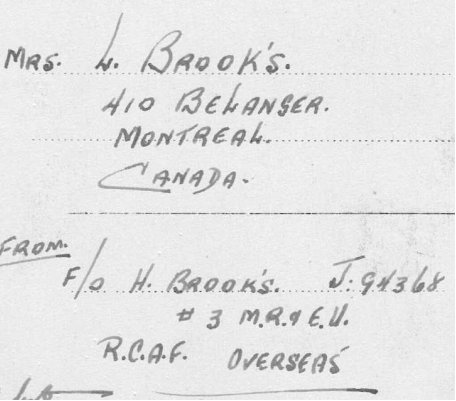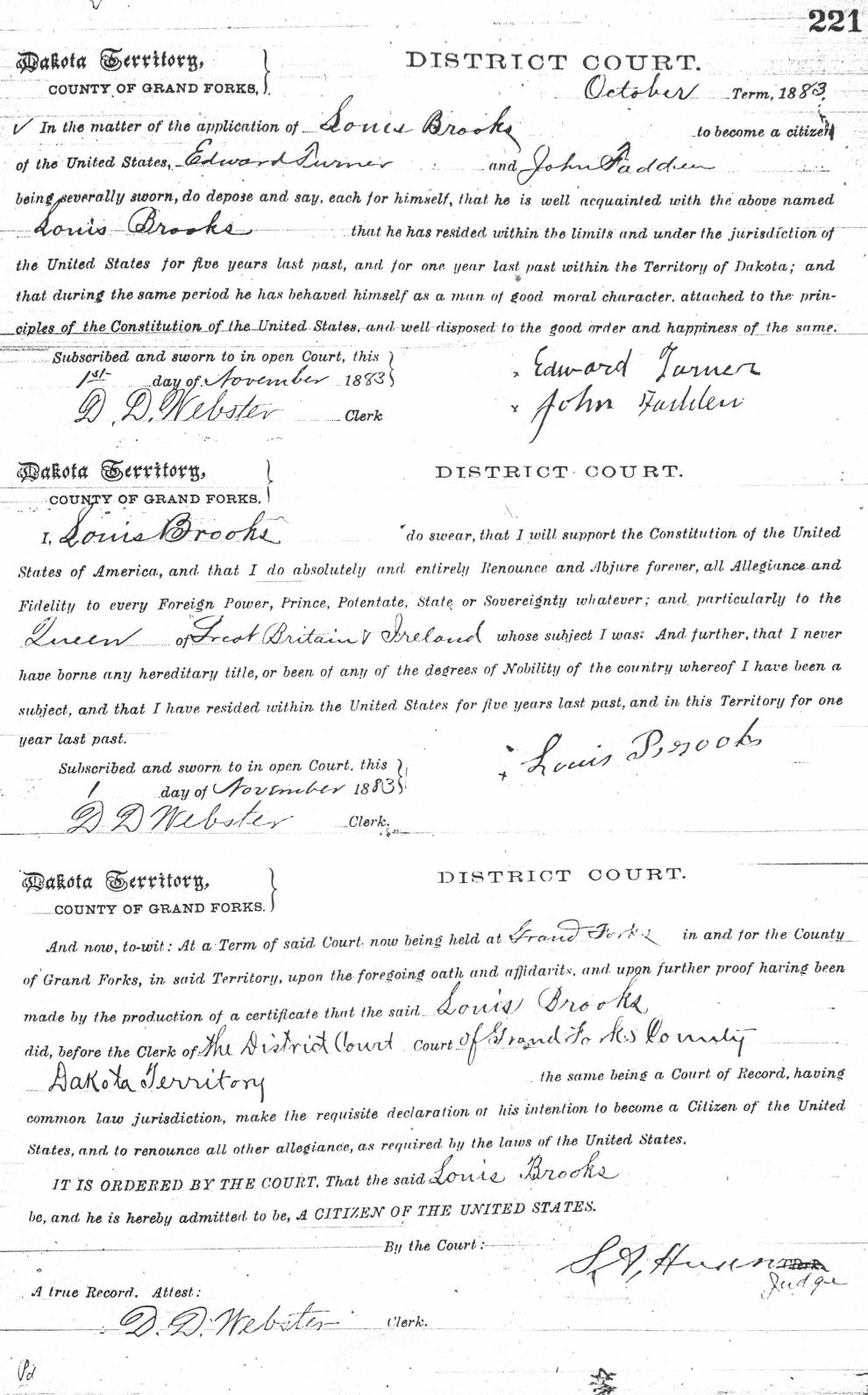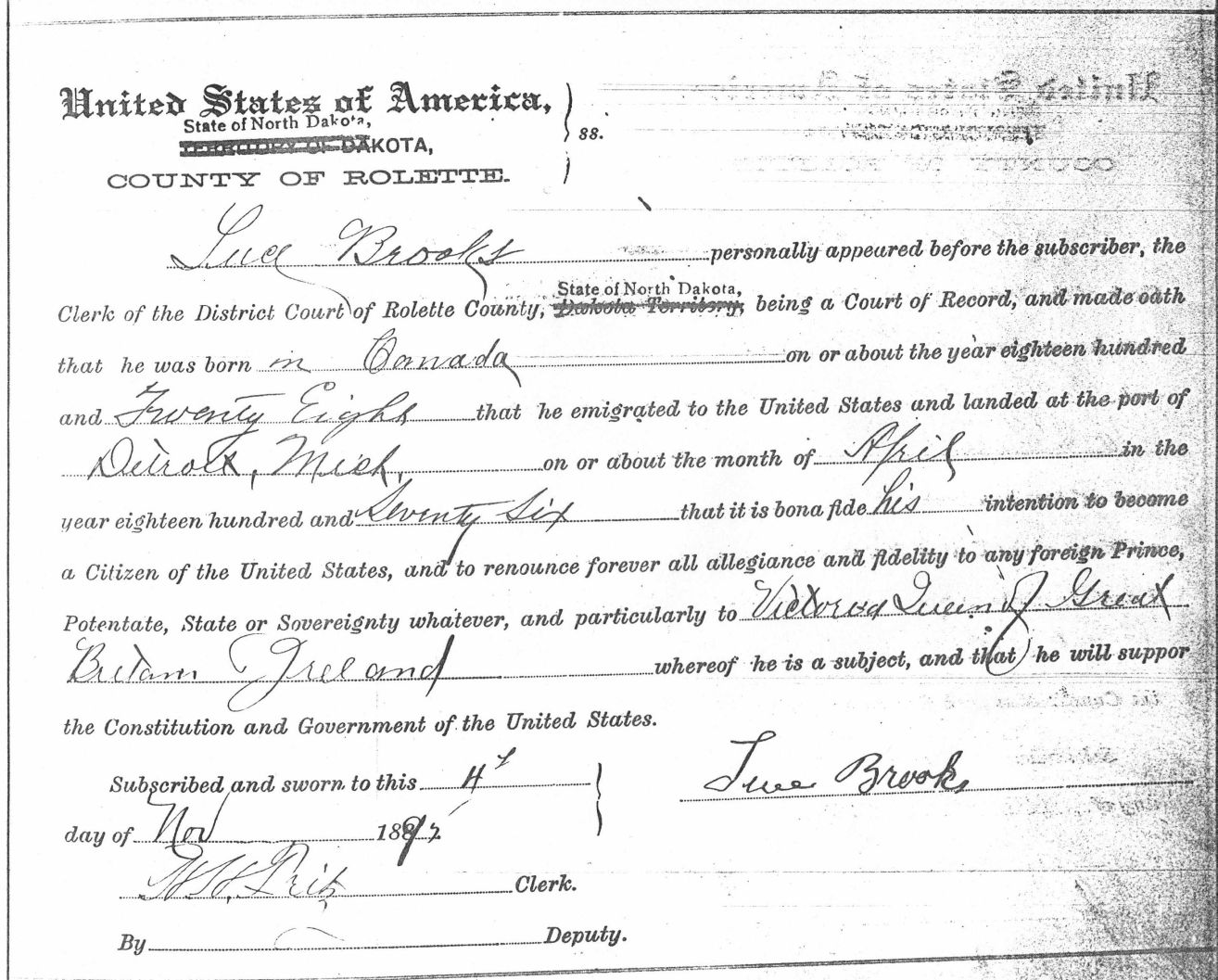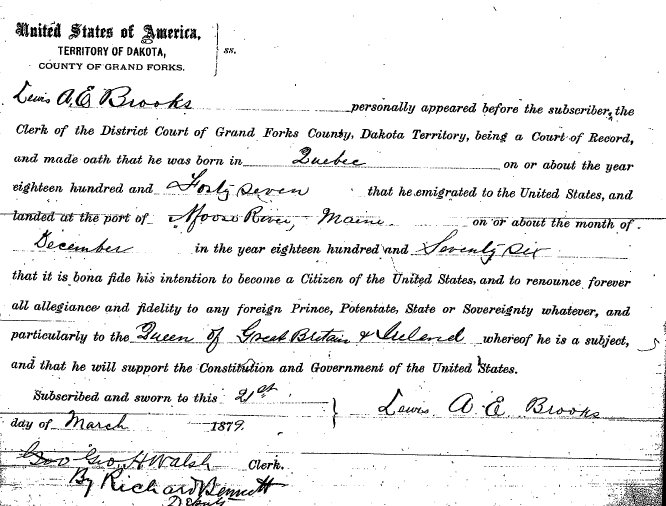
The Life and Times of Hubert Brooks M.C. C.D.
A Canadian Hero

 |
|
 |
Dakota Territory was created in 1861 and encompassed all of both North Dakota and South Dakota until 1887 when they were split (into North and South Dakota).
In 1863, the Homestead Act was passed and settlers flooded into the territory drawn by the rich dark soil of the RED RIVER VALLEY.
North and South Dakota achieved Statehood and entered the union on November 2, 1889
According to US CITIZEN NATURALIZATION RECORDS filed by Louis, Luce and Hubert Brooks (see section below) the immigration of the (then) Louis Rousseau family occured over the period April 1876 and March 1877.
It is not known for certain WHY the Rousseau clan chose Dakota Territory to move to. Perhaps positive feedback from friends/relations (such as Louis Huard) already living in the area and a generous homestead program were the enticements. Further, we know from the Grégoire Pioneer Biographies that wages in the Beauce area of Québec were next to nothing.
Louis Huard was the first to arrive in Grand Forks County circa 1864. Next to arrive was the Rousseau's in the April 1876 to March 1877 time period. Following the Rousseaus, Peter Marcoux, brother to Adele Philoméne Marcoux Grégoire, settled in Section 1 of Allendale Township of Grand Forks County in the spring of 1878. Peter was instrumental (perhaps augmented by feedback from the Huard and Rousseau families) in bringing both his brother Frank Marcoux and then the Grégoire�s to Dakota country. Tancrede Grégoire was the first Grégoire to come Grand Forks County in 1878 where he made his home with Peter Marcoux for the first couple of years. Alphonse Grégoire arrived in 1880. Shortly following their feedback the Marcoux and Grégoire immediate families departed Québec for Dakota Territory. The Marcoux and Grégoire families had livied close to the Rousseau and Huard families in Québec so it is suspected that combined feedback from both families accelerated the immigration cycle.
It also seems that the Grand Forks County Townships of Dakota Territory region attracted a migration
of a number of other French–Canadian families (as reported in the 1880 US Census and 1885 State Census) – perhaps drawn by the
network of a number of French Canadian catholic missionaries that had established beach heads in ‘the wilds’ of both Canada
and the USA and who communicated back to the parishes in Québec that settlers were needed.
(See also Newspaper article at bottom of previous section 2.4 on Rosalie Marcoux Turcotte that
discusses in some details reasons for migration of French Canadian settlers to the RED RIVER VALLEY of Grand Forks County.)
The immediate area around the Merrifield Roard which divides Allendale and Walle as well as Brenna and Grand Forks Townships was locally know as "Frog Pond" because of the large number of French Canadian settlers that inhabited the area.
Also in the mid 1870s/1880s the Dakota Territory and the regional railway were getting the word out that there was a lot of money to be made in the region – with the vertile soil of the RED RIVER VALLEY - so homesteaders were welcomed.
Louis Rousseau Brooks was to live in Grand Forks County for a period of almost 15 years from April 1877 to February 1892
where he passed away at the age of 67.
Son Hubert Rousseau Brooks was to stay in Grand Forks County also for a period of 15 years from 1877 to 1892 when he and his
family moved further north west in the state to St. John where they stayed until 1913 before emigrating back to CANADA (Saskatchewan).
The signed US NATURALIZATION RECORDS all taken in the Grand Forks / Rolette N.D indicate the following progressive DATES OF ENTRY into the US of the Rousseau/ Brooks family members:
| Louis/Luce Rousseau Family | Stated Birth Year of Person | Date of Entry to the US | Port of Entry to US |
| Son Louis Achille Brooks | 1855 | April 1871 | Portsmouth, New Hampshire |
| Mother Luce Brooks | 1828 | April 1876 | Detroit, Michigan |
| Son LAE (Louis Albert Euphreme) Brooks | 1847 | December 1876 | Moose River, Maine |
| Son Hubert Brooks | 1860 | March 1877 | Detroit, Michigan |
| Father Louis Brooks | 1824 | April 1877 | Duluth, Minnesota |
Note that all of these (then) Rousseau family members ended up in Grand Forks area as indicated in their US Naturalization paper applications (see section below).
What is interesting, is that they did not arrive together but rather over the space of approximately 1 year!
It is known that the Rousseau clan established itself in the eastern US. However it is not known how long son Louis
Achille stayed
in the Portsmouth N.H / eastern US region before moving to Grand Forks - that is, had he established himself in Grand Forks in time for his mother
Luce's immigration in April of 1876?
If not, it is strange that Luce would travel by herself to Grand Forks without husband Louis or another male escort. It is almost certain
that some other relation must have been already present in the Grand Forks area that Luce could travel to meet.
It is not known if the Rousseau/Brooks family members identified in this TABLE above travelled with
any other relations as these table entries are based solely on individual US Naturalization documents.
(Unfortunately the USA did NOT start retaining border crossing records until 1895 and Canada until 1908.)
It is thought that daughter Marie Germaine Florida (FLORA) Rousseau, then 7 years old, accompanied Luce
on her voyage to Grand Forks.
It is not thought that daughter Marie CLARA Rousseau, then 17 years old, accompanied Luce, as she
ended up marrying Eugene Turcotte on 9-April 1877 in STE�GERMAINE,DORCHESTER, Québec.
(It is not known if Luce Rousseau returned to Quebec to witness her daughter's wedding.)
It would seem right after this wedding, father Louis
departed for Grand Forks to join the rest of his family.
It is however reasonable to conclude from the port of entry into the US, that Luce, Hubert and Louis went directly to Grand Forks N.D. and did not temporarily settle in another town.
The North Dakota Pioneer Biography Files has a section on Tancrede Grégoire's travels from Québec to Grand Forks which captures some of the elements of the trip no doubt experienced by some of the Rousseaus.
Circa October 1878, Tancrede Grégoire travelled from his home in Québec to Sarnia, Ontario by rail. From Sarnia to Deluth, Minnesota he travelled by boat. This boat trip took 6 days.
He came from Deluth to Fischer�s Landing by rail, and then by stage to Grand Forks, Dakota Territory.
For some reason his ticket was made out to Winnipeg, Canada and they were going to take him there. He could not speak nor understand English, and had a hard time making the stage drivers understand that this
(Grand Forks) was his destination. He arrived in Grand Forks on a Saturday. That night he stayed at the house of Sam Huard in Grand Forks. On the Sunday following, his Uncle Peter Marcoux came to Grand Forks to
attend Father LeHiver's service at St Michael's Church and following service, Tancrede went home with his uncle.
Looking at the US Naturalization documents also filed in Grand Forks N.D. for Luce's HUARD family members indicate dates of immigration into the US of:
| Luce Huard's Family | Stated Birth Year of Person | Date of Entry to the US | Port of Entry to US |
| Brother Louis Huard | 1849 | June 1864 | Milwaukee, Wisconsin |
| Brother Joseph T. Huard | 1847 | April 1876 | (Port) Huron, Michigan |
It is also known from the 1880 US Census that brothers Louis and Joseph Huard were living in Grand Forks County in 1880.
It would seem to indicate that with brother Louis Huard arriving at Milwaukee, Wisconsin on the eastern shores of Lake Michigan in June 1864
that there was a HUARD family
presence in Grand Forks around the late 1864 time frame. So perhaps Luce Rousseau travelled in April 1876 to first meet up with her HUARD family
and then the
following year son Hubert and husband Louis followed. It would be interesting to understand why each of the family members travelled separately.
(Son John Hubert Rousseau would have been 17 years old - perhaps old enough to travel by himself in those days.)
Perhaps Louis stayed behind to wrap up his business or farm and/or sell their property in Quebec.
The other unusual item, was that Luce's brother Joseph T. Huard also travelled to Grand Forks in April of 1876 but apparantly did not travel with Luce as Joseph's port of entry was (Port) Huron, Michigan whereas Luce's was Detroit Michigan. Strange.
Unfortunately no formal border crossing records existed in 1876 – in fact they did not start until 1895.
It is known that daughter Marie Louise Philomene Agathe Rouseau had died suddenly on 12 Mar 1876 in Ste Germaine bringing sadness to the family. Perhaps this was a "trigger event" for a change. Most of the family had already left the house and had lives of their own. In those days the women married young as marriage was frankly their chief vehicle for financial support.
Recall that first son, Louis Albert Euphreme (LAE) Rousseau Brooks had married wife Mary Virginie Gagné January 1873 so he had been out of the house for a number of years. Again it is not known how long LAE Rousseau stayed on the US east coast before making his way to Grand Forks, but he ended up being an immediate neighbors to Hubert Rousseau Brooks in St. John.
Regardless, by the summer of 1877 Louis and Luce Rousseau has established themselves in Grand Forks ND USA.
(Originally called Les Grandes Fourches by French fur traders, Grand Forks was founded in 1870 by steamboat captain Alexander Griggs and incorporated on February 22, 1881. Located on the western banks of the Red River of the North in an extremely flat region known as the Red River Valley, the town was and is prone to flooding.)
The advent of river boat traffic and the first homestead activity brought early Canadian and American settlers to join the French-Indian families along the wooded sections of the Red and Turtle Rivers in the 1870�s. It was this kind of permanent settler that brought Father Simonet to the Grand Forks area in 1872. The priest, in writing to his Canadian Bishop in 1873 said, �I have seen 24 Catholic families within a distance of four miles and I was informed that almost all the other families up to the Crossing are also Catholic. I have promised to go back to Grand Forks in the Spring, and they are to try to build a temporary chapel.� And so St. Michael�s Catholic Church began. In 1883, the local newspaper said it was the �largest as well as the finest church edifice in Dakota.�
Grand Forks at that time was a small village with only a few board sidewalks and muddy streets. The east side of the village was bars and salons that any woman of repute stayed away from.
As discussed above, Luce Rousseau entered the US April 1876 and husband Louis Rousseau entered 1 year later in the month of April 1877.
The earliest "official" document found to date with the Rousseau name changed to BROOKS is the 1st filing for US Naturalization made by Louis Rousseau at Grand Forks, Dakota Territory on May 6, 1878 - a little less than 1 year after he'd arrived in Grand Forks!
Note that ‘brook’ is an English translation of French word ‘ruisseau’ which Louis thought was similar enough to Rousseau, perhaps also being influenced slightly by the ‘other Brooks families’ in the area.

|
As an aside, Joan Schaefer claims her grand mother, Marie Germaine Florida (Flora) Brooks Plante stated that the
name was changed from Rousseau to Brooks because no one seemed able to spell the name Rousseau! (We also saw this with the french first names being anglized as well.)
(In fact if one looks at the various Rousseau Genealogy Forms -- there were many Rousseau families - especially in the U.S.A. - who changed their
name from Rousseau to Brooks -- so this was a "more common" thing to do to fit in with ones english-speaking neighbors.)
The question has been, how did one go about making a name change circa the 1870s? After all no formal border records existed in
the US until 1895, and Dakota Territory wasn't to get its first Census until 1880.
According to Jim Davis of the State Archives of North Dakota;"Name changes were normally done when the naturalization records were processed.
If he (Louis) didn�t do it then, it would have been done in court, if he legally changed it. We would not have any of the Grand Forks
County court records and I�m not sure if these records survived the numerous floods that have occurred since the 1880�s.
From what I have seen on the naturalization records which were sent to you, he filed as Brooks so the name change was at that time or when he
lived in Canada."
Garlynn Helmoski, County Recorder for Grand Forks N.D. comments: "I am not 100% sure that a name change like this would have been recorded in our office, but it is hard to say what they did way back then. The only other place that I can think of for a name change is if it was done in the courts. I have no idea what the Clerk of District Court records are like back then (or at all, for that matter). That is the only other place that I can think of that may have record of a name change if it was not recorded against real estate property."
Formal enquiries were made with the Office Of Clerk of District Court of Grand Forks N.D. and their response was: "Unfortunately, our records (for that period) were lost in the flood of 1997. You might check the State Archives in Bismarck, North Dakota." (and of course the State Archives stated they had nothing, so unfortunately this avenue is a dead end)
Valerie Bowman had a very frank opinion" " The only subject that is in my "wheelhouse" is the name change/non-change thing. It is SUPER RARE to have anyone actually "officially" change their name. In the 1880 time period, there's probably about a 99+% chance the name just morphed. Immigrants, unable to spell properly (or even care) were dependent on others to write what they said. Even (as as an example) a poor farmer in Indiana in that time period was ill-educated and could likely not write, so it just became what it became. I have seen numerous documents that have the same man's last name (Bowman) spelled FOUR different ways. "My guy" had 12 mouths to feed and no education, so he really could give a rats rear about how someone spelled his name. When I first started doing this (geneaology), I'd fret over what the "real" name was until I realized it wasn't a matter of real or not, and was for me never about "who changed the spelling". Enumerators were notorious for spelling the way they heard, and it's well documented how names were documented as our ancestors stepped off those ships. So - it's highly unlikely (though not impossible) that these names were legally changed."
ALL SUBSEQUENT FORMAL DOCUMENTS for Louis Rousseau's family in Dakota Territory/ North Dakota --- from US Census, to
property documents to US Naturalization requests had the name Brooks with the NOTABLE EXCEPTION of:
1) the marriage of Hubert Rousseau to Marie Grégoire and
2) the births of Hubert and Marie's children: Siffroid Rousseau and Dora Rousseau with the parents using the last name Rousseau.
(Strangely Nellie was born as Nellie Brooks and Alfred as Alfred Brooks with the parents using the last name Brooks -- see following web PAGE on Hubert Brooks
family births in Grand Forks North Dakota.)
It is unclear why Hubert decided to use the last name of Rousseau for the births of Siffroid and Dora -- perhaps the church procedure was to use the parents birth christian last names, as Marie used hers as Marie Gregoire...... even then things are inconsistent with second child Nellie being born as a Brooks!
Although Louis Rousseau and family MAY have informally been using the name BROOKS prior to the May 6, 1878 1st
US Naturalization filing, at this point in the "discovery process", the Naturalization application is the FIRST OFFICIAL DOCUMENT FOUND where
the name of BROOKS is used or referenced.
(and as stated previously, this occured a little less than a year after Louis arrival in Grand Forks)
(Clearly as well the family must have discussed the name change and selected name at some length prior to the filing date.)
As an aside, Hubert Brooks (of Bluesky Alberta and who this biography is based) for the longest time insisted that the spelling of Brooks was Brook's with an apostrophe inserted between the ‘k’ and ‘s’. Although this can not be seen in the signatures of the other Brooks family members, some pictures exist of signs for Brook�s General Stores. (Yet another point I wish I would have followed up on!)


Louis, Luce and son Hubert became American citizens (according to the 1916 Canadian Census and the North Dakota Naturalization Records Index). Note that Louis and Hubert applied while the family was in Grand Forks, and Luce waited for some reason until after Hubert's passing and she was living with sister-in-law Flora in St. John.
| U.S. NATURALIZATION RECORDS | |||||||
| Lastname | Firstname | Country | Papers | Date | County | Volume | Page |
| Brooks | Louis | Canada | 1st | May 6, 1878 | Grand Forks | D-1 | 075 |
| Brooks | Louis | Canada | 2nd | November 1, 1883 | Grand Forks | F-21 | 221 |
| Brooks | Hubert | Canada | 1st | June 7, 1882 | Grand Forks | D-5 | 016 |
| Brooks | Luce | Canada | 1st | November 4, 1895 | Rolette | D-1 | 343 |
| Brooks | Lewis A E | Canada | 1st | March 21, 1879 | Grand Forks | D-1 | 245 |
| Brooks | Louis A | Canada | 1st | October 9, 1878 | Grand Forks | D-1 | 181 |
| Brooks | Louis A | Canada | 2nd | December 2, 1890 | Grand Forks | F-23 | 505 |
To become an American citizen back in the late 1800s required a 2 STEP PROCESS.
The first step was a Declaration of Intention (1st papers) that needed to be filed and then the second step occured with the
US naturalization occurring (2nd papers).
There was a five year waiting period between the Declaration of Intention and the Final or Petition to obtain citizenship.
Potential citizens did have to learn some elements of citizenship so some people were not ready to apply for their final papers after the five year
period. Also some people were not sure they wanted to stay in the United States so they may have delayed it for that reason.
Prior to 1906, decisions regarding citizenship applications and recording requirements were left up to local judges. There was no uniform outline
for keeping naturalization records. Federal and state courts and a series of federal agencies shared jurisdiction over naturalization. In North
Dakota, state district court judges normally conferred citizenship.
Note that although both Luce and Hubert declared that they were American citizens in their Canadian Homestead and Census filings, the formal set of 2nd papers to support the Final or Petition stage have not been located.
As an aside, an immigrant did have to apply for citizenship prior to applying for a homestead but
did not have to be a citizen to obtain the land.
This might explain why Louis Rousseau took out an application (declaration of intention) for US Citizenship so soon after his arrival in Grand Forks.
Unfortunately back in those days there was not much information required on the Naturalization forms to become an American citizen, so the forms below do not have the wealth of detail seen on the later forms (for example see Section A 6.6 for Dr. John Warren's Declaration of Intention form).
The Declaration of Intention (1st paper) for Louis Rousseau was shown in section A 4.4.1 above.
The 2nd set of papers to support the Final or Petition stage for Louis Rousseau are shown below.

|

|
No 2nd set of Final or Petition papers have been found for Hubert.

|
No 2nd set of Final or Petition papers have been found for Luce.

|
No 2nd set of Final or Petition papers have been found for Louis' eldest son LAE Brooks.

|
The 2nd set of papers to support the Final or Petition stage for Louis Achille Brooks are shown below.

|
| PREVIOUS PAGE | GO TO TOP OF PAGE FOR APPENDIX NAVIGATION MENU |
NEXT PAGE |
The Life and Times of Hubert Brooks M.C. C.D.